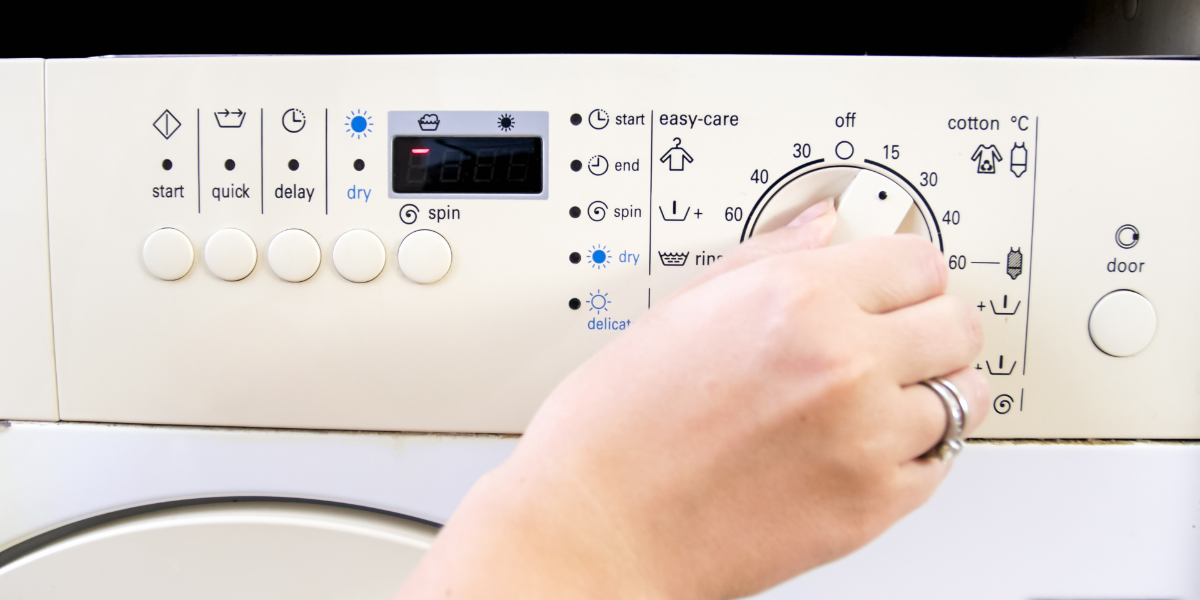Selecting the appropriate washing cycle at a laundromat is essential to effectively clean your clothes without damaging them. Here are some factors to consider:
Understand the Fabric Type and Care Labels: Clothing items come with care labels that indicate the recommended washing method. For example, delicate items require a gentle cycle, while heavy-duty fabrics such as jeans can withstand a regular or heavy-duty cycle.
Assess the Level of Dirtiness: If your clothes are heavily soiled, you may want to opt for a cycle with a pre-wash phase or an extra-long wash cycle. Lightly soiled clothes usually clean well in a regular or quick wash cycle.
Consider the Load Size: Washing machines at laundromats typically offer different load sizes. You'll want to choose a cycle that matches the amount of laundry you're washing to ensure efficiency and protect your clothes from damage due to overloading.
Water Temperature: Different fabrics and colors respond best to different water temperatures. Generally, cold water is gentle and prevents colors from fading or bleeding, making it suitable for most types of clothes. Warm water is ideal for synthetic, wrinkle-free materials, and hot water works best for heavily soiled clothes and sturdy fabrics like cotton.
Spin Speed: The spin speed can affect how dry your clothes are at the end of the wash. A high spin speed is effective for heavy items like towels and jeans, while a low spin speed is gentler and better for delicate items.
Lastly, remember to sort your laundry by color and fabric type before washing, and don't hesitate to ask the laundromat staff if you're unsure about what cycle to use. They are familiar with the machines and can provide guidance based on your specific laundry needs.
MOST POPULAR WASHING CYCLES’ DESCRIPTION
The wash, rinse, and spin cycles of a washing machine each have their own unique speeds, temperatures, and amounts of time that they are programmed to run for. The following are some of the most widespread ones:
Normal
The regular cycle, also known as the normal cycle, often combines a high-speed wash with a high-speed spin, which means that it is more damaging to your clothing. Because of this, you should limit its use to more durable textiles, such as cotton t-shirts and jeans.
Heavy duty
Utilizing the heavy duty cycle is the best option for cleaning work garments that wind up being extremely dirty. It is similar to the regular cycle in that it employs a high-speed wash and spin, but it is more thorough in that it lasts for a longer period of time and utilizes more water, making it simpler to eliminate stains.
Bedding/bulky things
The cycle designated for bedding or bulky goods should be used for washing bigger items such as blankets, sheets, and carpets. This is because the name of the cycle makes the implication clear. In most cases, this starts with an extended time of soaking, and is then followed by a wash cycle performed at medium speed, followed by a spin cycle.
Permanent press/casual
Choose the permanent press cycle for synthetic fabrics and colored items. This cycle has a medium-speed wash cycle, a low-speed spin cycle, a cold rinse, and a resting time to limit the amount of wrinkling that occurs throughout the washing process.
Delicate
Because agitation and tumbling might end up damaging the delicate textiles, you need to utilize a washing cycle that employs low-speed wash and spin cycles when you want to clean them. Additionally, the wash cycle for delicates is often much shorter.
TOP TIPS FOR USING A LAUNDROMAT SERVICE
The role of laundromats in cost-effective laundry care is significant, yet the importance of selecting suitable settings and detergent is equally crucial. Incorrect selections can either compromise the cleanliness of your clothes or even lead to potential damage. Understanding the care labels on your clothes can serve as a guiding map towards the right settings. They provide valuable information about the suggested water temperature and cycle for each garment, directly impacting the care and longevity of your clothes.
Fabric type is another critical determinant in this process. Certain fabrics, especially delicate ones, require a gentler wash cycle accompanied by a mild detergent to preserve their quality and structure. Another factor that could influence the choice of detergent is the hardness of water in your location. Hard water conditions might necessitate a detergent inclusive of a water softener for efficient cleaning results. Overloading the washer not only hinders the cleaning process but can also be detrimental to the machine. So, maintaining a balance between the washer's capacity and the load size is essential.
It's equally important to ensure the appropriate quantity of detergent is dispensed, depending on the size of your load. Overuse or underuse of detergent can lead to unsatisfactory washing results.
Further considerations for laundromat use include using high-efficiency (HE) detergent if your washer is compatible. These HE detergents are formulated specifically for HE washers, contributing to water and energy conservation. Additionally, air-drying your clothes, whenever possible, can add to the longevity of your garments and contribute to energy savings.
These considerations, while seeming simple, play a crucial role in ensuring your clothes remain clean, fresh, and undamaged. Careful attention to these details can significantly enhance your laundromat experience.

Join The Discussion!